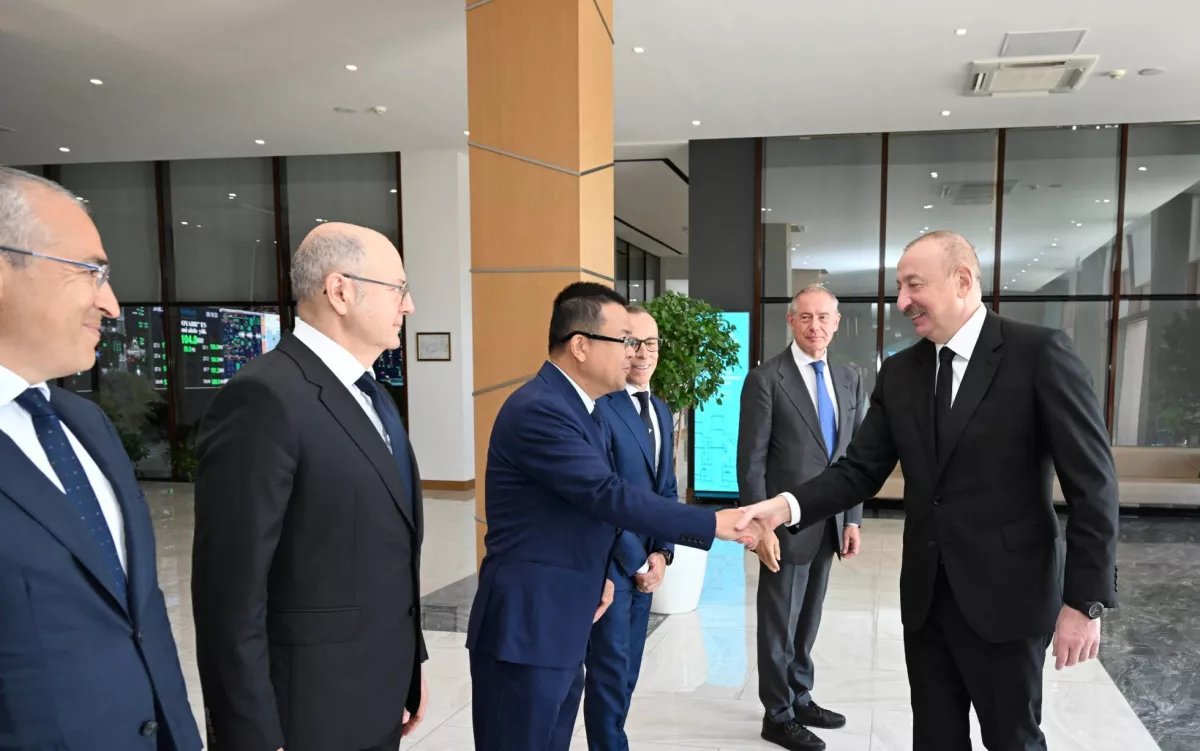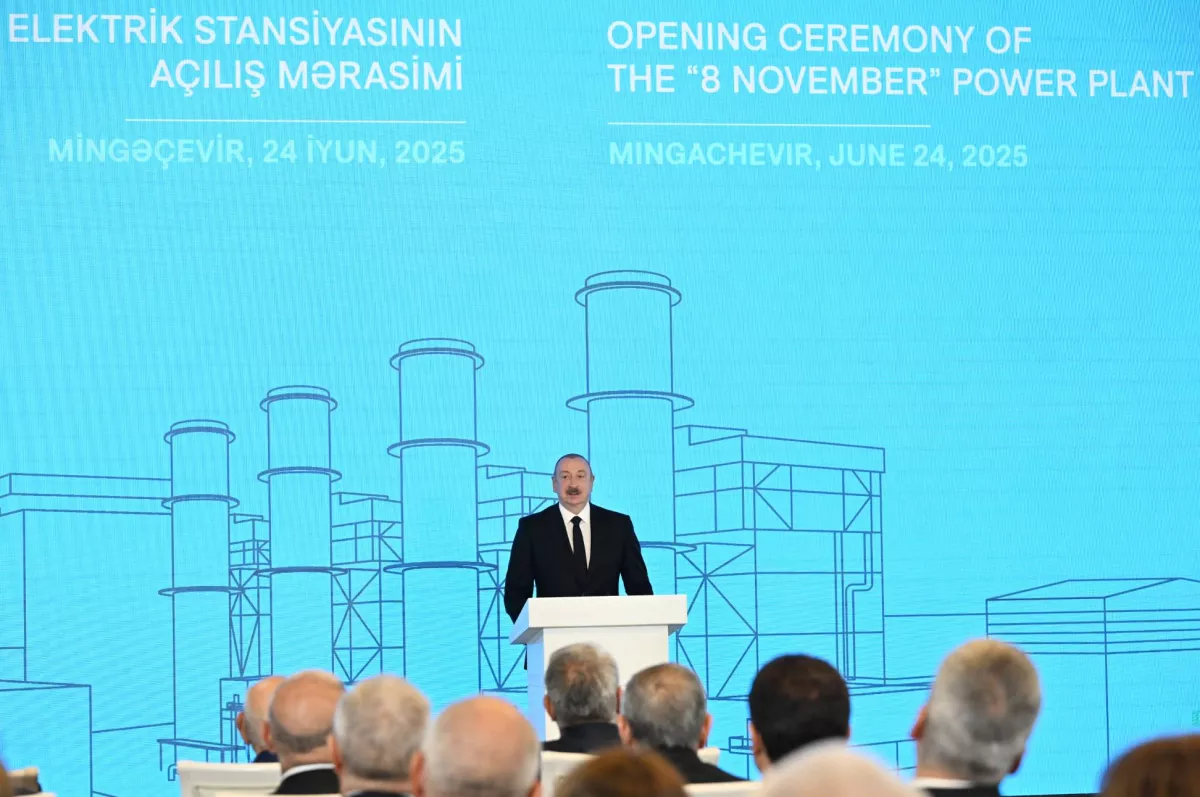“November 8” power plant: Azerbaijan’s new energy triumph Energy as strategy
Over the past 20 years, Azerbaijan has transformed from a country reliant on imported electricity into the largest producer and exporter of electricity in the South Caucasus. The pace of commissioning new power generation facilities has accelerated dramatically in recent years. To ensure grid stability and expand export capacity, new transmission infrastructure—including power lines and substations—has also been developed.
A major milestone in this progress was the inauguration of the “November 8” power plant in Mingachevir, attended by President Ilham Aliyev. The day before, the president also oversaw the launch of the Central Aran regional SCADA control centre and the 110/35/10-kilovolt Yevlakh nodal substation, further strengthening the national energy network.
Today, Azerbaijan boasts the most powerful electric power system in the South Caucasus. It is anchored by 22 large thermal power plants and more than 30 hydroelectric stations of varying capacities, most of which are operated by the state-owned company AzerEnergy OJSC. According to Yusif Garayev, First Deputy Vice President of AzerEnergy, the country’s total installed generation capacity has increased by 2,676 megawatts since 2018.
Including renewable energy sources—such as small hydropower plants, solar, wind, and other facilities owned by both the state and private investors—Azerbaijan’s total installed capacity reached 8,976 megawatts in 2025.
With this robust generation potential, Azerbaijan has been a net exporter of electricity for nearly 17 years, consistently meeting domestic demand while supplying power to regional and international markets.
As part of the next phase in strengthening Azerbaijan’s energy capacity, construction began in February 2023 on what will become the largest thermal power plant (TPP) in the South Caucasus. Located in the city of Mingachevir, the facility will have a planned capacity of 1,880 megawatts.
Key components have already been installed, including gas turbines and generators supplied by Italian manufacturer Ansaldo Energia, as well as waste heat recovery boilers and transformer units from China’s Dongfang Electric. Supporting infrastructure has also been developed: a high-pressure gas pipeline was connected to the plant, a gas distribution station was built, and both a water-cooling system and a water treatment facility were established. Additionally, control and telemetry systems have been implemented, and major expansion work has been carried out at the 500 kV and 330 kV substations.
Now, less than two and a half years after construction began, a grand inauguration ceremony was held for the new thermal power plant in Mingachevir, named “November 8” in honour of Azerbaijan’s historic victory in the 44-day war for the liberation of Karabakh. During the ceremony, President Ilham Aliyev met with distinguished guests and emphasised the significance of the project, as well as the vital role played by Italian and Chinese companies in its realisation.

“Both Italy and China are strategic partners of Azerbaijan. Two declarations on strategic partnership have been signed with Italy and two with China,” President Aliyev stated during his address.
As part of the opening events, the president received in Mingachevir a high-level delegation led by Adolfo Urso, Minister for Enterprises and Made in Italy, and Chen Qiang, Chairman of the Board of Dongfang Electric International Corporation. During the meeting, both sides reaffirmed the importance of the project, highlighted the successful cooperation with Italian and Chinese firms, and exchanged views on prospects for future collaboration.
“Over the past 20 years, we have built the energy system of Azerbaijan almost from scratch. New power plants have been constructed in various parts of the country. Reconstruction work has also been carried out in Mingachevir,” the head of state noted during the ceremony.
The president recalled that Mingachevir has played a central role in Azerbaijan’s energy sector since the 1970s. In 1974, at the initiative and under the direct leadership of National Leader Heydar Aliyev, the foundation of the “Azerbaijan” Thermal Power Plant was laid in Mingachevir. By 1981, the plant’s first unit was commissioned. With the subsequent launch of additional units, the facility grew to become one of the key energy hubs of the South Caucasus during the Soviet era.
In the early years of independence, when Azerbaijan faced severe energy shortages due to fuel supply disruptions and an outdated power system, the “Azerbaijan” TPP played a critical role in ensuring electricity supply to both households and industries.
“In 2018, the foundation for the reconstruction of the ‘Azerbaijan’ Thermal Power Plant was laid, and on June 25, 2020, exactly five years ago, the plant was given a new life,” the president noted. “Currently, the generation capacity of the ‘Azerbaijan’ Power Plant is 1,800 megawatts, the capacity of the ‘8 November’ Plant is 1,880 megawatts, and the capacity of the Hydroelectric Power Plant is more than 400 megawatts.”
President Ilham Aliyev emphasised that more than 40% of the country’s electricity is currently generated in Mingachevir. He added that the ‘November 8’ power plant will significantly enhance Azerbaijan’s energy capacity, improve the efficiency of the national power system, and further cement Mingachevir’s role as a major energy hub — not only for Azerbaijan but for the entire South Caucasus region.

“The implementation of this project in such a short period of time – power engineers know this well – can be considered a record achievement. The construction period of a power plant with a capacity of about 2,000 megawatts usually takes several years – perhaps three, four, five years, or even longer. For example, during the Soviet era, the construction of the “Azerbaijan” Thermal Power Plant in Mingachevir began in 1974, and the first unit was commissioned in 1981. In other words, after seven years, 300 megawatts of energy were obtained. We have now obtained about 2,000 megawatts of energy in just two years,” the president emphasised. “Naturally, our existing energy base here, our experience, the professionalism, knowledge, and skills of Azerbaijani power engineers, and, of course, the contribution of our international partners have all played a role.”
The Azerbaijani president also noted that the commissioning of the “November 8” power plant will help achieve several other objectives: “As I mentioned earlier, it will increase the efficiency of our energy system, expand our potential, generation capacity, and significantly reduce conventional fuel consumption. Thus, this will create an opportunity for us to save natural gas. Because everyone knows very well that there is a great demand for Azerbaijani gas in world markets today, and the more we save natural gas domestically, the greater our export potential will be.”

Expanding the capacity of the national energy sector has been identified as a core priority in Azerbaijan’s economic strategy, with a strong focus on increasing electricity exports to large Turkish and European markets. To achieve this, Azerbaijan is implementing a variety of projects, including the development of renewable energy sources (RES) with the support of foreign investors. Solar, wind, and other generating facilities are being constructed on the Absheron Peninsula.
Similar efforts are underway in the Karabakh region and the Nakhchivan Autonomous Republic, where small hydropower plants are being modernised and newly built, high-voltage power lines are being installed, and powerful substations constructed. Over the past five years alone, 38 hydroelectric power plants with a combined capacity of 307 MW have been built or renovated in territories liberated from occupation. Crucially, these efforts aim not only to ensure a stable energy supply for Karabakh but also to boost the region’s export potential.
The next milestone came on June 23 with the inauguration of the Central Aran Regional SCADA Control Centre of Azerishig OJSC in Yevlakh, alongside the commissioning of the 110/35/10-kilovolt Yevlakh nodal substation. President Ilham Aliyev attended the opening ceremony of these vital energy infrastructure facilities.
Vugar Ahmadov, Chairman of Azerishig OJSC, briefed the president on the centre’s objectives and equipment. The facility features two 35/10-kilovolt power transformers with a capacity of 6.3 MVA each, and modern enclosed switchgear operating at 35 kV and 10 kV. A 14-kilometre power transmission line was also installed, connecting the Yevlakh substation to the control centre.
The substations of Delimammadli, Kurekchay, Aghdash, Agsu, Tartar, and Reinforced Concrete Products have been integrated into the Central Aran Regional SCADA Control Centre. Equipped with state-of-the-art digital technology, this new centre will ensure uninterrupted, stable, and efficient electricity management for agricultural, industrial, strategic state facilities, the service sector, and the general population.
On the same day, President Ilham Aliyev also attended the inauguration of the 110/35/10-kilovolt Yevlakh nodal substation. This substation is crucial for supplying electricity to over 180,000 residents across the entire Yevlakh district, parts of the Barda and Ujar districts, and for integrating green energy from the Varvara hydroelectric power plant into the national grid. The outdoor switchgear has been upgraded, and the substation is now equipped with advanced digital systems.
Additionally, a three-story Regional Training, Education, and Laboratory Centre for Azerenergy OJSC has been built on the substation premises. Fully equipped with modern devices and simulators, the centre will provide engineering training and professional development courses across 12 specialisations.








